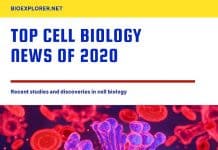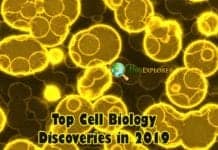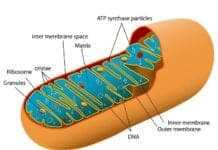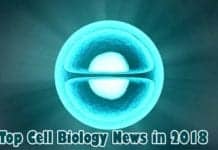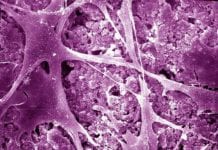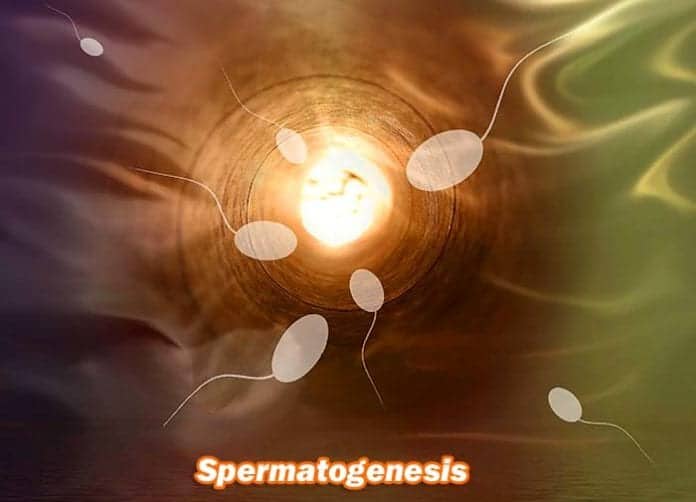
Spermatogenesis: In the animal kingdom (among dioecious animals), the union of the sperm and egg is the foundation of reproduction of the species. On the one hand, female fertility requires the production of the gamete by the ovary whereas male fertility requires the production of the gametes by the testis.
Males produce their gametes through a process called spermatogenesis. Let’s take a closer look at how this complex process occurs.
Table of Contents
What is Spermatogenesis?
Spermatogenesis is the production of sperm from the primordial germ cells within the male reproductive organs, the testes. The process of spermatogenesis occurs in the epithelium of the seminiferous tubules, with the spermatogonia and the spermatozoa at the lumen of the border of the tubule.
- Within the walls, there are cells called the Sertoli cells that support and nourish the sperm cells by supplying blood products and nutrients. As they grow, the Sertoli cells aid them to be transported up to the central channel of the tubule.
- The next generation of sperm cells are already deposited during birth but are still in the inactive state until puberty. When a male reaches adolescence, hormones from the anterior pituitary activates the production of sperm cells (and continues up to senility).
![]()
Developmental Stages of Spermatogenesis
In general, spermatogenesis is divided into two developmental stages: spermatocytogenesis and spermiogenesis. The said stages are illustrated and described below.
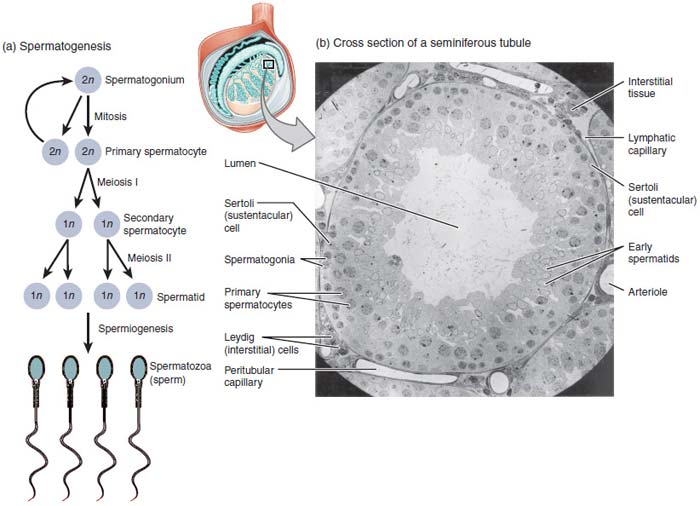
1. Spermatocytogenesis
Spermatocytogenesis is a developmental stage that includes a series of cell divisions during which spermatogonia differentiate into spermatids.
Mitosis
Mitosis is a type of cell division wherein the parent cell typically divides into two daughter cells that have exactly the chromosome number as the parent.
- During this phase of spermatocytogenesis, the spermatogonia (primitive cells) increase their number through mitosis. This step ends when a spermatogonium divides into two primary spermatocytes.
Meiosis I
On the other hand, meiosis is the type of cell division that involves the division of the chromosome number into the half.
- The next step to mitosis is the division of the primary spermatocytes to form the secondary spermatocyte. In this stage, the cells will have to undergo through meiosis I where their previously diploid chromosome number will be reduced into half.
Meiosis II:
After meiosis I, the secondary spermatocytes will immediately undergo meiosis II to produce the spermatids.
- Each secondary spermatocyte will form two spermatids. The release of the follicle stimulating hormone (FSH) into the testes will help in the development of the Sertoli cells and will help these spermatids mature as they undergo spermiogenesis.
![]()
2. Spermiogenesis
On the other hand, spermiogenesis is the stage where spermatids differentiate. While the cells during the stage of spermatocytogenesis are typically rounded in appearance, they will dramatically change this configuration when they enter spermiogenesis, where they will have to be adapted for fertilization.
- During spermiogenesis, the nucleus will condense, the acrosome (sperm cap) will be formed, and the tail (of the sperm) will be formed. The mitochondria will also be concentrated in the middle piece of the sperm as it will help for its motility.
- It is important to note that during spermiogenesis, the cell will not divide but rather simply differentiate like what has mentioned above.
![]()
Once matured, the sperm cells will be transported through the seminiferous tubules and stored in the epididymis of the testes until they are released outside the male body.
Tabulated below are the steps in spermatogenesis and how long they take to occur.
| Stage | Time |
|---|---|
| Spermatocytogenesis (Mitosis of the spermatogonia) | 16 days (up to the primary spermatocytes) |
| Spermatocytogenesis (Meiosis I) | 24 days (for the division of the primary spermatocytes to from the secondary spermatocytes) |
| Spermatocytogenesis (Meiosis II) | A few hours (for engendering the spermatids) |
| Spermiogenesis | 24 days (up to the completed sperm cells) |
| TOTAL: ~ 64 days |
For more visualizations of the process, you may want to check this video.
To learn more about Human Physiology as a free online course, you may visit this website: http://janux.ou.edu
Physiology of Spermatogenesis
The maturation of the male reproductive system happens under the influence of the hormone testosterone which primarily removes unnecessary cytoplasm and organelles. These unnecessary cytoplasms are known as residual bodies and are engulfed by the Sertoli cells found in the testes. The result of the engulfment is spermatozoa which are mature but lack motility, hence are sterile. Nevertheless, through spermiation, these spermatozoa can be released into the seminiferous tubule.
- The process of spermatogenesis is very sensitive to any changes as mere fluctuations in the number of hormones and temperature in the body can affect it. In particular, the epithelium of the seminiferous tubule is easily affected by elevation of temperature (even normal body temperature). Hence, the testes are located outside the body in a sack called scrotum.
- Surprisingly, the optimal temperature in the testes is maintained at about 34-35 degrees Celsius in human males.
- In addition to temperature, deficiencies in dietary nutrients like vitamins and minerals, infectious diseases, and alcohol can affect spermatogenesis.
![]()
Differences Between Spermatogenesis and Oogenesis
As its name suggests, oogenesis is the opposite of spermatogenesis–oogenesis is the process of forming the egg, the female gamete. Unlike spermatogenesis that occurs in the seminiferous tubule, oogenesis occurs in the ovaries of the female reproductive organ. Other differences between the two are outlined in the table below.
| Spermatogenesis | Oogenesis |
|---|---|
| Meiosis occurs right after mitosis. | Meiosis only occurs once when a certain population of cells is reached. |
| Four gametes are produced during meiosis. | One gamete is produced during meiosis. |
| Meiosis is finished after a few days or week. | Meiosis is completed only after months or years. |
| Meiosis proceed continuously. | Meiosis is arrested at the prophase of meiosis I. |
| Sex chromosomes are excluded from recombination and transcription. | All chromosomes exhibit the same transcription and recombination. |
While much has already been known about male reproduction, to date, no specific about the functions of Sertoli cells are available. The development of more accurate evaluation techniques would greatly enhance our understanding spermatogenesis and the function of Sertoli cells process.
But looking into it, isn’t amazing how this process is carried out without one’s consciousness is the secret for the perpetuation of the animal kingdom?
![]()
Cite This Page
References
- “Spermatogenesis – Developmental Biology – NCBI Bookshelf”. Accessed February 14, 2018. Link.
- “Human Reproductive Anatomy and Gametogenesis | Boundless Biology”. Accessed February 14, 2018. Link.
- “Spermatogenesis | physiology | Britannica.com”. Accessed February 14, 2018. Link.
- “”. Accessed February 14, 2018. Link.
- “Spermatogenesis – My Agriculture Information Bank”. Accessed February 14, 2018. Link.
- “Physiology of the Male Reproductive System | Boundless Anatomy and Physiology”. Accessed February 14, 2018. Link.


